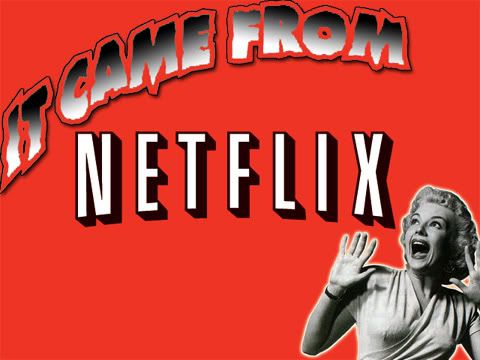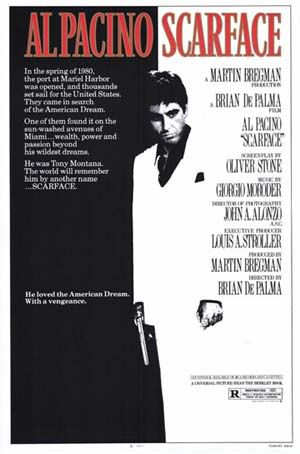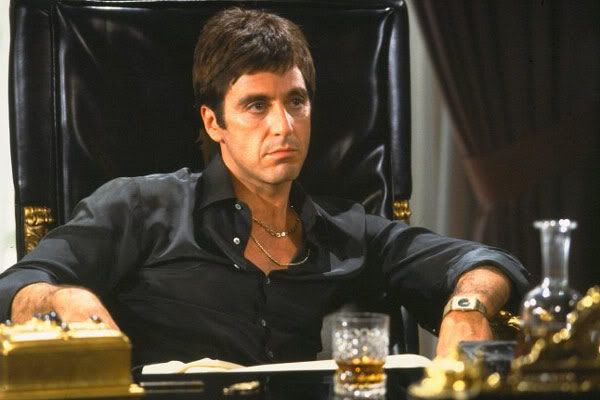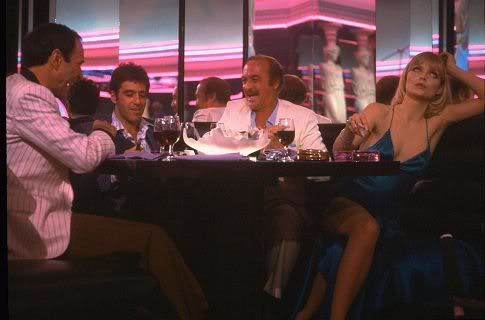
[audio:http://www.blueinkalchemy.com/uploads/scarface.mp3]
Tragedies are touchpoints in the course of human history. They’re also cautionary tales, whispering warnings of downfalls to come. From Aeschylus to Shakespeare, it’s a tradition with thousands of years worth of wisdom to teach us through the abrupt ends of others’ lives, especially those who choose to pursue their goals through illegitimate means. It’s just as true today as it was in 1983 when Brian De Palma’s Scarface first premiered in theaters. I don’t know if this visionary director and his young cast who became household names knew that this gaudy, baroque and melodramatic opus would still have something to say to a 21st-century audience, but it does, and like the main character, it isn’t shy about it.

Originally a tale of Prohibition-era organized crime, Scarface updated its setting to southern Florida, when hundreds of thousands of refugees fled Communist-controlled Cuba for the United States hoping for a better future. For the criminals free of Cuba’s prisons among those refugees, that better future meant the fast money and high risk that came from a life of crime. And for Tony Montana, one of those criminals, the money was in cocaine. With his partner Manny, Tony almost immediately begins carving out a place for himself. He comes into the country with nothing, yet he soon is the premiere trigger-man for the biggest drug dealer in Miami. And he doesn’t stop there.
Scarface is a tale of excess from the very beginning in both plot and production. The patterns and colors of the early 80s are garish reminders that throwbacks like Grand Theft Auto: Vice City are not exaggerating. The score, heavy in ominous synth, is as cheesy as the zebra-print seat covers in Tony’s Cadillac and yet every bit as fitting. The multiple mirrors in the nightclubs our protagonist spends his leisure time in made shooting difficult but underscore the vanity of the time and the character. Of course all of the production value in the world is for naught without a central presence to drive the narrative, and Tony Montana is definitely behind the wheel in that regard.

“I jus’ wan’ what’s comin’ t’ me: th’ world… an’ everythin’ in it.”
In future films such as Heat or Carlito’s Way (not so much Devil’s Advocate), Pacino will ratchet back the over-the-top scenery-chewing bombast to save it for key moments. But in Scarface, he seems to be firing on all cylinders at all times. Be he clawing his way up to the top or sliding down into oblivion, Tony lives with his dials turned to 11 and beyond. Not only does his behavior lead to him ensuring he alone remains the center of his universe, he’s proud of this way of life and his achievements to a tragic fault. There’s very little about this protagonist that’s redeemable or even all that likable, yet his tragic humanity keeps us watching every move he makes.
The rest of the cast certainly isn’t slouching, either. It was a breakout role for Michelle Pfieffer and the first on-screen appearance ever for Mary Elizabeth Mastrantonio. De Palma directs them all with the graceful nuance of an orchestra conductor as well as the uncompromising drive of a workshop foreman. As bold as a decision it was to shoot this picture at all, he went one step further in making it almost three hours long and including some incredibly brutal scenes of bodily harm from shootouts to stabbings. It’s an endurance trial made survivable and even enjoyable thanks to Tony Montana.

Good times had by all. Mostly.
The presence of Montana is a pervasive one, even to this day. Scarface would inspire a plethora of crime dramas around the world, and its themes of freedom, excess and the rags-to-riches rise to power is clearly an inspiration for not only a good deal of gangster rappers but video games like the aforementioned Grand Theft Auto and, later, Saint’s Row. What the games leave out, of course, is the way the story ends. Once he achieves all he’s been after, Tony spirals into a miasma of vanity and contempt, even for himself. He’s an utterly repulsive human being, even acknowledging his villainous status at one point in a memorable black-tie dinner scene, yet he seems confused when people curse him and leave him on his own. And there’s plenty of cursing to be sure; screenwriter Oliver Stone used the word “fuck” and its many derivations 218 times in the screenplay.
Scarface is highly recommended. Be prepared to spend an afternoon with Tony, watching him banter with immigration, deal with Bolivian drug lords using surprising charisma and build his own cocaine empire from scratch yet at the same time finding true happiness eluding him at every turn. In the end he stares at a mountainous pile of drugs on his luxurious desk in his palatial Miami estate, and his hollow eyes echo the question he put to Manny at dinner: “Is this it?” It’s a moment of introspection and humbling, almost pathetic pathos which, after a lifetime of deception, theft, seduction and murder, has come too little too late. I’m sure that, almost 30 years later, we can find a message for our time between the bullet-riddled corpses and the bright, happy neon lights – even if that message is merely one of the rules that Tony neglected to follow: “Never get high on your own supply.”
Josh Loomis can’t always make it to the local megaplex, and thus must turn to alternative forms of cinematic entertainment. There might not be overpriced soda pop & over-buttered popcorn, and it’s unclear if this week’s film came in the mail or was delivered via the dark & mysterious tubes of the Internet. Only one thing is certain… IT CAME FROM NETFLIX.


